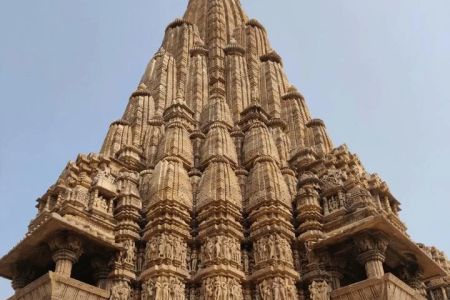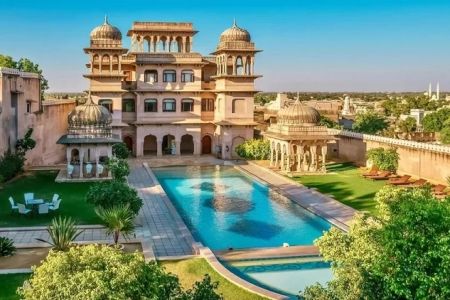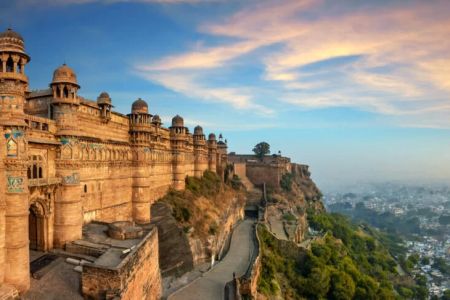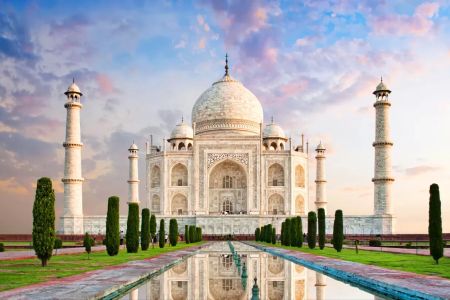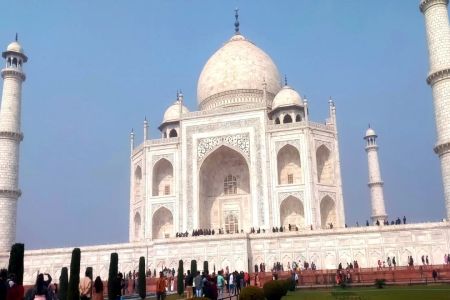Top UNESCO World Heritage Sites in India
1. Taj Mahal
The Taj Mahal, one of the most famous UNESCO World Heritage Sites in India, is a stunning white marble mausoleum located in Agra, Uttar Pradesh. Built by Emperor Shah Jahan in memory of his beloved wife Mumtaz Mahal, the Taj Mahal is a symbol of eternal love and architectural beauty. The intricate carvings, expansive gardens, and reflecting pools create a serene atmosphere, making it a must-visit destination for travelers seeking both history and romance.
Traveler's Experience
As I walked through the gates of the Taj Mahal, the first view of the magnificent structure took my breath away. The gleaming white marble seemed to glow under the sun, and the tranquil gardens added to the sense of peace that enveloped the site. Whether you’re visiting at sunrise for a more peaceful experience or in the evening to watch the changing colors of the sky, the Taj Mahal never fails to impress.
2. Qutub Minar
Standing at 72.5 meters, the Qutub Minar in Delhi is the tallest brick minaret in the world and a UNESCO World Heritage Site that showcases India's rich Islamic history. This stunning tower is made of red sandstone and is adorned with intricate inscriptions and carvings. Visitors can also explore the surrounding Qutub complex, which includes the Iron Pillar and other historical monuments.
Traveler's Experience
Climbing the steps of the Qutub Minar offers a chance to experience a piece of history while being rewarded with a stunning panoramic view of the surrounding area. The complex exudes an ancient charm, with every stone seemingly telling a story of India’s past.
3. Red Fort
Located in the heart of Delhi, the Red Fort is a symbol of India's Mughal past. This majestic fort complex, made of red sandstone, served as the residence of Mughal emperors for over 200 years. The fort's massive walls, intricate architecture, and lush gardens make it one of the most iconic UNESCO World Heritage Sites in India.
Traveler's Experience
As you walk through the imposing gates of the Red Fort, you’re immediately transported back in time. The fort’s historical significance is palpable, especially when you visit the Diwan-i-Aam (Hall of Public Audience) and the Diwan-i-Khas (Hall of Private Audience), where emperors once held court.
4. Mahabodhi Temple
Located in Bodh Gaya, Bihar, the Mahabodhi Temple is a sacred pilgrimage site for Buddhists. It is here that Siddhartha Gautama, the Buddha, attained enlightenment under the Bodhi tree. The temple’s peaceful surroundings, the ancient Bodhi tree, and the towering spire make it a revered and serene spot for travelers interested in spiritual history.
Traveler's Experience
The peaceful ambiance of Mahabodhi Temple is like no other. Sitting under the Bodhi tree, I felt an overwhelming sense of calm and connectedness to the centuries of history that have unfolded in this sacred place.
5. Khajuraho Group of Monuments
Located in Madhya Pradesh, the Khajuraho Group of Monuments is famous for its stunning temples adorned with intricate sculptures depicting various aspects of life, including divine figures, animals, and scenes of everyday activities. The unique blend of Hindu and Jain architectural styles makes this UNESCO World Heritage Site a fascinating destination for history and art lovers.
Traveler's Experience
The sculptures at Khajuraho are nothing short of awe-inspiring. As I walked around the temples, I found myself admiring the detailed craftsmanship of each figure, which brought the stories of ancient India to life in a way that was both educational and captivating.
6. Fatehpur Sikri
Fatehpur Sikri, a former Mughal capital, is a city built by Emperor Akbar in the late 16th century. This UNESCO World Heritage Site features a stunning blend of Persian, Indian, and Islamic architectural styles. The city includes magnificent structures like the Buland Darwaza, Jama Masjid, and Panch Mahal, making it a fascinating glimpse into the grandeur of the Mughal Empire.
Traveler's Experience
Fatehpur Sikri is a city frozen in time. As I wandered through the vast courtyards and palaces, I could almost hear the echoes of the Mughal court’s bustling activity. The massive Buland Darwaza, with its intricate carvings, was particularly striking.
7. Sundarbans National Park
The Sundarbans National Park, located in West Bengal, is a UNESCO World Heritage Site known for its unique ecosystem, including the largest mangrove forest in the world. The park is home to the famous Royal Bengal Tiger, along with a wide variety of other wildlife species. The labyrinth of waterways and dense forests make it a prime destination for nature and wildlife enthusiasts.
Traveler's Experience
Exploring the Sundarbans was an adventure like no other. Cruising through the dense mangrove forests, I felt a sense of excitement and awe as I witnessed diverse wildlife in their natural habitat, including a glimpse of the elusive Bengal tiger.
Each of these UNESCO World Heritage Sites in India offers a unique and enriching experience. From the grandeur of the Taj Mahal to the spiritual serenity of the Mahabodhi Temple, these destinations allow travelers to dive deep into India’s diverse history and culture. Whether you’re a history buff, architecture enthusiast, or nature lover, India’s UNESCO sites promise to leave you with unforgettable memories. Want to explore these iconic destinations? Visit Travel India One to plan your dream trip to India today!

